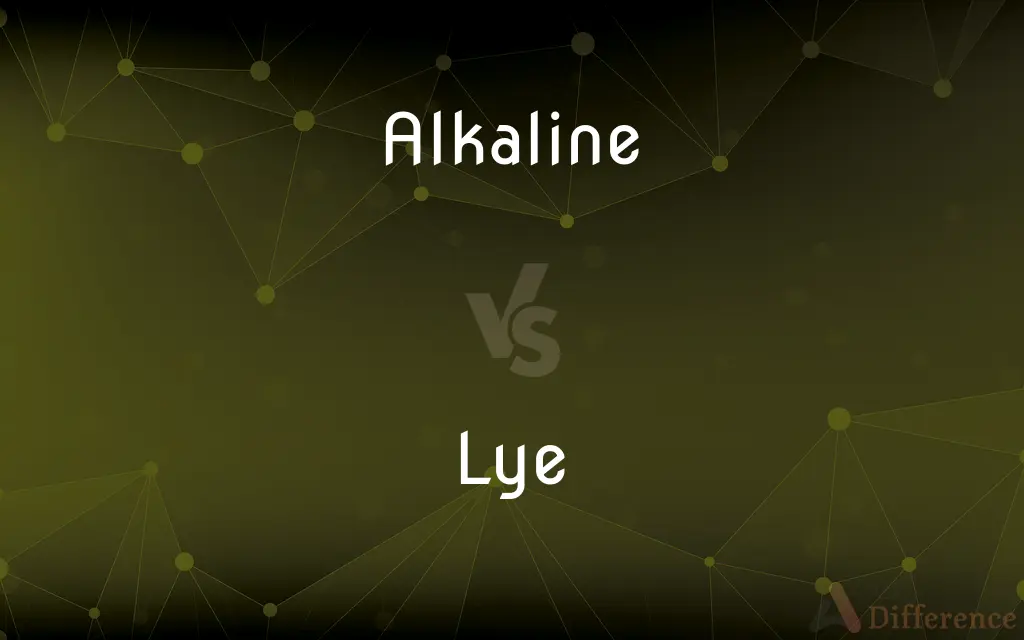Alkaline vs. Lye — What's the Difference?
Edited by Tayyaba Rehman — By Urooj Arif — Updated on April 8, 2024
Alkaline substances have a pH above 7 and are basic, neutralizing acids, whereas lye specifically refers to strong alkaline solutions used in cleaning and making soap.

Difference Between Alkaline and Lye
Table of Contents
ADVERTISEMENT
Key Differences
Alkaline substances are characterized by their pH level, which is above 7, indicating their basic nature. They can be found in various forms, from liquids to solids, and are commonly present in many household items and foods. On the other hand, lye is a specific type of highly caustic alkaline substance, usually in the form of sodium hydroxide (NaOH) or potassium hydroxide (KOH), known for its strong cleaning and saponification abilities.
While alkaline compounds are essential for balancing the pH levels in our bodies and environments, playing critical roles in metabolism and water purification, lye is used industrially and domestically for more intensive purposes. These include soap making, drain cleaning, and as a chemical reactant. Whereas the term "alkaline" can apply to a broad spectrum of substances, "lye" refers to a narrow group with more concentrated properties.
The health and safety risks associated with alkaline substances generally depend on their concentration and the specific compound. Mildly alkaline substances are often safe for consumption or use in products. However, lye demands cautious handling due to its corrosive nature, capable of causing severe burns upon contact with skin or eyes and damaging organic materials.
In the culinary world, alkaline ingredients are used to modify flavors, tenderize meats, and influence the texture and color of foods, such as in baking soda (sodium bicarbonate) applications. Lye, however, is specifically utilized in preparing certain foods like pretzels, where it contributes to the unique taste and glossy appearance by altering the surface pH.
Environmentally, alkaline substances can contribute to reducing acidity in soils and water bodies, benefiting agriculture and aquatic life. Conversely, lye must be handled with environmental caution due to its potential for chemical burns and its ability to react vigorously with acids, necessitating careful disposal and use to avoid damaging ecosystems.
ADVERTISEMENT
Comparison Chart
Definition
Substances with a pH above 7, showing basic properties.
Strong alkaline solutions, typically sodium or potassium hydroxide.
Uses
Balancing pH in bodies and environments, food preparation.
Soap making, drain cleaning, chemical reactant.
Safety
Varies by concentration; generally safe in low concentrations.
Highly caustic, requires careful handling to avoid burns.
Culinary Application
Flavor modification, meat tenderizing, texture and color enhancement.
Specific uses like pretzel preparation for taste and appearance.
Environmental Impact
Can reduce soil and water acidity, beneficial in moderation.
Requires cautious disposal due to potential harm to ecosystems.
Compare with Definitions
Alkaline
A substance with a pH greater than 7.
Baking soda is often used in baking for its alkaline properties.
Lye
A strong alkaline solution, often sodium hydroxide.
Lye is essential for traditional soap making.
Alkaline
Basic and neutralizing acids.
Antacids contain alkaline compounds to neutralize stomach acid.
Lye
Used in cleaning agents for its caustic nature.
Commercial drain cleaners often contain lye to dissolve clogs.
Alkaline
Common in many household products.
Glass cleaners often have alkaline ingredients to break down grime.
Lye
Must be disposed of properly to prevent environmental damage.
Neutralizing lye before disposal is necessary to protect waterways.
Alkaline
Present in some foods naturally.
Bananas are known for their alkaline content.
Lye
Involved in food preparation like pretzel making.
Lye bath gives pretzels their distinctive texture and flavor.
Alkaline
Important for maintaining bodily pH balance.
The blood's slightly alkaline nature is crucial for health.
Lye
Can cause severe burns upon contact.
Handling lye requires protective gear to prevent skin damage.
Alkaline
Of, relating to, or containing an alkali.
Lye
A lye is a metal hydroxide traditionally obtained by leaching wood ashes, or a strong alkali which is highly soluble in water producing caustic basic solutions. "Lye" most commonly refers to sodium hydroxide (NaOH), but historically has been used for potassium hydroxide (KOH).
Alkaline
Having a pH greater than 7.
Lye
A strongly alkaline solution, especially of potassium hydroxide, used for washing or cleansing.
Alkaline
Having a relatively low concentration of hydrogen ions.
Lye
The liquid obtained by leaching wood ashes.
Alkaline
Of or relating to a common disposable battery made of zinc and manganese dioxide.
Lye
See potassium hydroxide.
Alkaline
Of, or relating to an alkali, one of a class of caustic bases.
Lye
See sodium hydroxide.
Alkaline
(chemistry) Having a pH greater than 7.
Lye
An alkaline liquid made by leaching ashes (usually wood ashes).
Alkaline
An alkaline battery.
Lye
Potassium or sodium hydroxide (caustic soda).
Alkaline
Of or pertaining to an alkali or to alkalies; having the properties of an alkali.
Lye
Obsolete spelling of lie
Alkaline
Relating to or containing an alkali; having a pH greater than 7;
Alkaline soils derived from chalk or limestone
Lye
A short side line, connected with the main line; a turn-out; a siding.
Lye
To treat with lye.
Lye
Obsolete spelling of lie.
Lye
A strong caustic alkaline solution of potassium salts, obtained by leaching wood ashes. It is much used in making soap, etc.
Lye
Sodium hydroxide or potassium hydroxide, or a concentrated aqueous solution of either compound.
Lye
A short side line, connected with the main line; a turn-out; a siding.
Lye
A falsehood.
Lye
A strong solution of sodium or potassium hydroxide
Common Curiosities
How is lye different from other alkaline substances?
Lye refers specifically to strong alkaline solutions used for cleaning and making soap, known for their caustic nature.
Why is lye used in soap making?
Lye reacts with fats and oils in a process called saponification to produce soap.
What makes a substance alkaline?
Alkaline substances have a pH level above 7, indicating a basic nature.
Can all alkaline substances be safely consumed?
While many alkaline substances are safe in low concentrations, their safety for consumption depends on the specific compound and concentration.
What precautions should be taken when disposing of lye?
Lye should be neutralized and disposed of properly to prevent environmental damage and personal injury.
What is the role of alkalinity in the human body?
Alkaline compounds help maintain the body's pH balance, crucial for proper metabolic functions.
Can alkaline substances be used in food preparation?
Yes, certain alkaline substances are used for flavor modification, meat tenderizing, and influencing food texture and color.
Are there safety concerns associated with using lye?
Yes, lye can cause severe chemical burns and requires careful handling and proper protective gear.
How do alkaline substances affect environmental pH?
Alkaline substances can neutralize acids, potentially reducing acidity in soils and water bodies.
Can alkaline substances be found in natural environments?
Yes, alkaline substances occur naturally in some soils and waters, influencing the pH balance of those environments.
How does lye contribute to the food industry?
Lye is used in certain food preparations for its ability to alter texture and flavor, such as in pretzel making.
What is the significance of pH in determining a substance's alkalinity?
The pH scale measures a substance's acidity or basicity (alkalinity), with values above 7 indicating an alkaline nature.
How does the concentration of an alkaline substance impact its use and safety?
The concentration affects both the substance's effectiveness in various applications and the safety precautions needed during handling.
Why is lye considered more hazardous than other alkaline substances?
Lye's high causticity and potential for severe burns make it particularly hazardous, requiring more stringent safety measures.
What are common household products that contain alkaline substances?
Cleaning agents, laundry detergents, and baking soda are common household products containing alkaline substances.
Share Your Discovery

Previous Comparison
Sector vs. Domain
Next Comparison
Language vs. ScriptAuthor Spotlight
Written by
Urooj ArifUrooj is a skilled content writer at Ask Difference, known for her exceptional ability to simplify complex topics into engaging and informative content. With a passion for research and a flair for clear, concise writing, she consistently delivers articles that resonate with our diverse audience.
Edited by
Tayyaba RehmanTayyaba Rehman is a distinguished writer, currently serving as a primary contributor to askdifference.com. As a researcher in semantics and etymology, Tayyaba's passion for the complexity of languages and their distinctions has found a perfect home on the platform. Tayyaba delves into the intricacies of language, distinguishing between commonly confused words and phrases, thereby providing clarity for readers worldwide.
















































